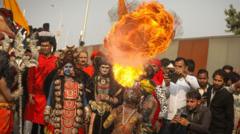An unprecedented number of pilgrims gather to cleanse their souls in India's most revered rivers over the coming weeks.
Massive Religious Gathering Kicks Off in India: The Mahakumbh Mela

Massive Religious Gathering Kicks Off in India: The Mahakumbh Mela
The Mahakumbh Mela begins, drawing millions to Prayagraj for a sacred experience.
In the vibrant northern Indian city of Prayagraj, a historic religious event, the Mahakumbh Mela, has commenced, attracting millions of devotees. This monumental festival, known as the largest gathering of humanity in the world, will see Hindus from across the globe descend upon the holy site over a span of six weeks. The main attraction is the sacred bathing ritual at Sangam, the revered confluence of the Ganges, Yamuna, and the mythical Saraswati river. Many attendees believe that immersion in these sacred waters will absolve them of sins.
To accommodate the influx of visitors, authorities have constructed an expansive tent city, sprawling across 4,000 hectares of land along the riverbanks. The atmosphere is alive with colorful processions, where pilgrims, adorned in traditional attire, sing and dance as they make their way to the holy site. The festival is anticipated to attract around 400 million attendees during its 45-day duration.
As the event unfolds, participants can witness various rituals, including groups of ash-smeared devotees engaging in sacred practices typical of the Kumbh. This ancient tradition is celebrated despite the frigid temperatures, as many devotees brave the cold to partake in the spiritual cleansing. The tent city, which began construction last September, provides vital resources and shelter to this vast number of spiritual seekers.
The Mahakumbh Mela, revered as the planet’s largest religious festival, will culminate on the 26th of February, with a significant presence of Hindu holy men, including the striking Naga sadhus — ascetics known for their fearless plunges into the icy waters. This gathering represents not only faith and tradition, but also an overwhelming sense of community and spiritual fervor among millions seeking enlightenment and peace.
To accommodate the influx of visitors, authorities have constructed an expansive tent city, sprawling across 4,000 hectares of land along the riverbanks. The atmosphere is alive with colorful processions, where pilgrims, adorned in traditional attire, sing and dance as they make their way to the holy site. The festival is anticipated to attract around 400 million attendees during its 45-day duration.
As the event unfolds, participants can witness various rituals, including groups of ash-smeared devotees engaging in sacred practices typical of the Kumbh. This ancient tradition is celebrated despite the frigid temperatures, as many devotees brave the cold to partake in the spiritual cleansing. The tent city, which began construction last September, provides vital resources and shelter to this vast number of spiritual seekers.
The Mahakumbh Mela, revered as the planet’s largest religious festival, will culminate on the 26th of February, with a significant presence of Hindu holy men, including the striking Naga sadhus — ascetics known for their fearless plunges into the icy waters. This gathering represents not only faith and tradition, but also an overwhelming sense of community and spiritual fervor among millions seeking enlightenment and peace.






















